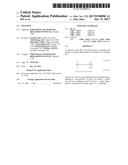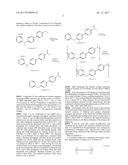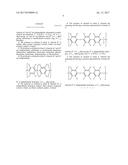Patent application title: POLYMER
Inventors:
Po-Hsien Ho (Taipei City, TW)
Chih-Hsiang Lin (Taipei City, TW)
Chih-Hsiang Lin (Taipei City, TW)
Meng--Hsin Chen (Xinpi Township, TW)
Cheng-Hsing Fan (Tainan City, TW)
Hsin-Ching Kao (Baoshan Township, TW)
Yih-Her Chang (Baoshan Township, TW)
Yih-Her Chang (Baoshan Township, TW)
Assignees:
INDUSTRIAL TECHNOLOGY RESEARCH INSTITUTE
IPC8 Class: AC08G750227FI
USPC Class:
1 1
Class name:
Publication date: 2017-07-13
Patent application number: 20170198098
Abstract:
A polymer is provided. The polymer has a repeating unit having a
structure represented by Formula (I) or Formula (II)
##STR00001##
wherein Ar.sup.1 and Ar.sup.2 can be substituted or unsubstituted aryl
diradical; Y.sup.- can be R.sup.2SO.sub.3.sup.- or ClO.sub.4.sup.-;
R.sup.1 can be C.sub.1-6 alkyl; Ar.sup.1 and Ar.sup.2 are different; and,
R.sup.2 can be C.sub.1-6 alkyl, substituted or unsubstituted aromatic
ring, or C.sub.1-6 haloalkyl.Claims:
1. A polymer, which has a repeating unit having a structure represented
by Formula (I) or Formula (II) ##STR00011## wherein Ar.sup.1 and
Ar.sup.2 are independently substituted or unsubstituted aryl diradical;
Y.sup.- is R.sup.2SO.sub.3.sup.- or ClO.sub.4.sup.-; R.sup.1 is C.sub.1-6
alkyl group; Ar.sup.1 and Ar.sup.2 are different; and, R.sup.2 is
C.sub.1-6 alkyl group, substituted or unsubstituted aromatic ring, or
C.sub.1-6 haloalkyl.
2. The polymer as claimed in claim 1, wherein R.sup.1 is methyl, ethyl, propyl, isopropyl, n-butyl, t-butyl, sec-butyl, isobutyl, pentyl, or hexyl.
3. The polymer as claimed in claim 1, wherein Ar.sup.1 and Ar.sup.2 are independently substituted or unsubstituted phenylene, biphenylene, naphthylene, thienylene, indolylene, phenanthrenylene, indenylene, anthracenylene, or fluorenylene.
4. The polymer as claimed in claim 1, wherein Ar.sup.1 and Ar.sup.2 are independently ##STR00012## R.sup.3 is independently hydrogen, or C.sub.1-6 alkyl group.
5. The polymer as claimed in claim 4, wherein R.sup.3 is independently hydrogen, methyl, ethyl, propyl, isopropyl, n-butyl, t-butyl, sec-butyl, isobutyl, pentyl, or hexyl.
6. The polymer as claimed in claim 1, wherein the repeating unit having a structure represented by Formula (I) is ##STR00013## wherein R.sup.1 is C.sub.1-6 alkyl group; R.sup.3 is independently hydrogen, or C.sub.1-6 alkyl group; and, Y.sup.- is R.sup.2SO.sub.3.sup.- or ClO.sub.4.sup.-.
7. The polymer as claimed in claim 1, wherein the repeating unit having a structure represented by Formula (II) is ##STR00014## wherein R.sup.3 is independently hydrogen, or C.sub.1-6 alkyl group.
Description:
CROSS REFERENCE TO RELATED APPLICATIONS
[0001] This application claims the benefit of U.S. Provisional Application No. 62/277,091, filed on Jan. 11, 2016, which is incorporated herein by reference.
[0002] The application is based on, and claims priority from, Taiwan Application Serial Number 105142916, filed on Dec. 23, 2016, the disclosure of which is hereby incorporated by reference herein in its entirety.
TECHNICAL FIELD
[0003] The disclosure relates to a polymer, and in particular to a polyarylene sulfide (PAS) or a salt thereof.
BACKGROUND
[0004] Polyarylene sulfide (PAS) is a material with good physical characteristics such as thermal resistance, chemical resistance, flame resistance, and electrical insulation characteristics. Thus, polyarylene sulfide (PAS) can be used in computer accessories and auto accessories; as a coating for parts that come into contact with corrosive chemicals; and as industrial fibers having chemical resistance.
[0005] One conventional method for producing polyarylene sulfide (PAS) is the halogen-containing process that, in principle, results in a low yield of polyarylene sulfide (PAS) and produces unrecyclable halogen-containing byproducts that can cause environmental pollution. In addition, conventional polyarylene sulfides (PAS) with two different repeating units are generally arranged in a random fashion, so that the thermal resistance, chemical resistance, flame resistance, and electrical insulation characteristics of the conventional polyarylene sulfides cannot be enhanced.
SUMMARY
[0006] According to embodiments of the disclosure, the disclosure provides a polymer having a repeating unit having a structure represented by Formula (I) or Formula (II):
##STR00002##
wherein Ar.sup.1 and Ar.sup.2 can be independently substituted or unsubstituted aryl diradical; Y.sup.- can be R.sup.2SO.sub.3.sup.- or ClO.sub.4.sup.-; R.sup.1 can be C.sub.1-6 alkyl group; Ar.sup.1 and Ar.sup.2 are different; and, R.sup.2 can be C.sub.1-6 alkyl group, substituted or unsubstituted aromatic ring, or C.sub.1-6 haloalkyl group.
[0007] A detailed description is given in the following embodiments with reference to the accompanying drawings.
DETAILED DESCRIPTION
[0008] Embodiments of the disclosure provide a polymer, such as polyarylene sulfide (PAS) or a salt thereof. According to embodiments of the disclosure, the main chain of the polymer of the disclosure consists of different aryl groups alternately arranged. Therefore, the polymer of the disclosure exhibits relatively high crystallinity and melting point (such as larger than or equal to about 330.degree. C.). Moreover, the thermal resistance, chemical resistance, flame resistance, and electrical insulation characteristics of the polymer are improved.
[0009] According to embodiments of the disclosure, the polymer of the disclosure can have a repeating unit having a structure represented by Formula (I) or Formula (II):
##STR00003##
wherein Ar.sup.1 and Ar.sup.2 can be independently substituted or unsubstituted aryl diradical; Y.sup.- can be R.sup.2SO.sub.3.sup.- or ClO.sub.4.sup.-; R.sup.1 can be C.sub.1-6 alkyl group; Ar.sup.1 and Ar.sup.2 are different; and R.sup.2 can be C.sub.1-6 alkyl group, substituted or unsubstituted aromatic ring, or C.sub.1-6 haloalkyl group. Herein, the substituted aryl diradical of the disclosure means that at least one hydrogen atom bonded to carbon atoms of the aryl diradical can be replaced with C.sub.1-6 alkyl group. According to embodiments of the disclosure, the substituted aromatic ring means that at least one hydrogen atom bonded to carbon atoms of the aromatic ring can be replaced with C.sub.1-6 alkyl group.
[0010] According to embodiments of the disclosure, Ar.sup.1 and Ar.sup.2 can be independently substituted or unsubstituted phenylene, biphenylene, naphthylene, thienylene, indolylene, phenanthrenylene, indenylene, anthracenylene, or fluorenylene, wherein the substituted phenylene, substituted biphenylene, substituted naphthylene, substituted thienylene, substituted indolylene, substituted phenanthrenylene, substituted indenylene, substituted anthracenylene, or substituted fluorenylene mean that the substituted aryl diradical of the disclosure means that at least one hydrogen atom bonded to carbon atoms of the aryl diradical can be replaced with C1-6 alkyl group.
[0011] According to embodiments of the disclosure, C.sub.1-6 alkyl group of the disclosure can be a linear or branched C.sub.1-6 alkyl group. For example, R.sup.1 can be methyl, ethyl, propyl, isopropyl, n-butyl, t-butyl, sec-butyl, isobutyl, pentyl, or hexyl.
[0012] According to embodiments of the disclosure, Ar.sup.1 and Ar.sup.2 can be independently
##STR00004##
x can be 0, 1, or 2; R.sup.3 can be independently hydrogen, or C.sub.1-6 alkyl group. For example, R.sup.3 can be independently hydrogen, methyl, ethyl, propyl, isopropyl, n-butyl, t-butyl, sec-butyl, isobutyl, pentyl, or hexyl.
[0013] According to embodiments of the disclosure, the repeating unit having a structure represented by Formula (I) can be
##STR00005##
and the repeating unit having a structure represented by Formula (II) can be
##STR00006##
wherein R.sup.1, R.sup.3, and Y.sup.- have the same definition as above.
[0014] According to embodiments of the disclosure, the degree of polymerization of the polymer of the disclosure can be adjusted. For example, the polymer of the disclosure can have a number average molecular weight from about 600 to 120,000, or have a number average molecular weight from about 10,000 to 30,000.
[0015] According to embodiments of the disclosure, the method for preparing the polymer of the disclosure includes reacting a compound having a structure represented by Formula (III) with acid, obtaining a polymer with a repeating unit having a structure represented by Formula (I):
##STR00007##
wherein Ar.sup.1 can be substituted or unsubstituted aryl diradical, such as substituted or unsubstituted phenylene, biphenylene, naphthylene, thienylene, indolylene, phenanthrenylene, indenylene, anthracenylene, or fluorenylene; Ar.sup.3 can be substituted or unsubstituted aryl group, such as substituted or unsubstituted phenyl group, biphenyl group, naphthyl group, thienyl group, indolyl group, phenanthrenyl group, indenyl group, anthracenyl group, or fluorenylene group. The substituted aryl group means that at least one hydrogen atom bonded to carbon atoms of the aryl group can be replaced with C.sub.1-6 alkyl group. Ar.sup.1 and Ar.sup.3 can be derived from different compounds. For example, when Ar.sup.1 is phenylene, Ar.sup.3 is not phenyl group. The aforementioned acid can be sulfuric acid, methanesulfonic acid, benzenesulfonic acid, p-toluenesulfonic acid, or trifluoromethanesulfonic acid. The acid can react with the compound having a structure represented by Formula (III). In addition, the excessive acid can also serve as the reaction solvent.
[0016] Furthermore, the anionic ion (Y.sup.-) of the polymer with a repeating unit having a structure represented by Formula (I) can be further replaced with other anionic ion (such as CH.sub.3SO.sub.3.sup.-), obtaining a polymer with other anionic ion.
[0017] Moreover, the polymer with a repeating unit having a structure represented by Formula (I) can be further reacted with a nucleophile to undergo a dealkylation, obtaining polymer with a repeating unit having a structure represented by Formula (II). According to embodiments of the disclosure, the nucleophile can be metal halide, metal hydroxide, alcohol, amine (such as secondary amine or tertiary amine), or thiol. For example, the nucleophile can be sodium chloride, potassium chloride, aluminum chloride, or 4-methylpyridine.
[0018] The inventive concept of the disclosure may be embodied in various forms without being limited to the exemplary embodiments set forth herein.
Example 1
[0019] 0.7 g of methyl phenyl sulfoxide and 1 g of methyl biphenyl sulfide were added into a reaction bottle under a nitrogen atmosphere, and then cooled to 0.degree. C. Next, 10 ml of methanesulfonic acid was added slowly into the reaction bottle, and then stirred for 30 min. After raising the temperature back to room temperature, the mixture was stirred for 20 hr. Next, the result was poured into 40 ml of perchloric acid, and then stirred for 1 hr. Next, the mixture was extracted three times using 50 ml of dichloromethane and 100 ml of water as the extraction solvent, and then the organic phase was collected. After drying, filtering and concentrating the organic phase, Compound (1), with a yield of about 92%, was obtained. The synthesis pathway of the above reaction was as follows:
##STR00008##
[0020] Compound (1) was analyzed by nuclear magnetic resonance (NMR) spectroscopy and the result is as follows: .sup.1H NMR (400 MHz, ppm, CDCl.sub.3): 2.48 (--CH.sub.3, s), 3.67 (sulfonium-CH.sub.3, s), 7.40-7.94 (aromatic H, 13H, m). Furthermore, Compound (1) was analyzed by liquid chromatography-mass spectrometry (LC-MS) and the result is as follows: m/z=323 (excluding anionic ion CH.sub.3SO.sub.3.sup.-).
[0021] Next, 1.9 g of Compound (1) and 30 ml of acetic acid were added into a reaction bottle under a nitrogen atmosphere. After stirring for several minutes, 2.02 ml of hydrogen peroxide was added slowly into the reaction bottle. After stirring for 90 min, the result was extracted three times using 50 ml of dichloromethane and 100 ml of water as the extraction solvent, and then the organic phase was collected. After drying, filtering and concentrating the organic phase, Compound (2) (orange), with a yield of about 92%, was obtained. Next, 10 ml of 4-methylpyridine and Compound (2) were added into a reaction bottle under a nitrogen atmosphere, and then stirred for 30 min. After heating to reflux for 20 min, Compound (3) was obtained. The synthesis pathway of the above reaction was as follows:
##STR00009##
[0022] Compound (3) was analyzed by nuclear magnetic resonance (NMR) spectroscopy and the result is as follows: .sup.1H NMR (400 MHz, ppm, CDCl.sub.3): 2.72 (--CH.sub.3, s), 7.38-7.63 (aromatic H, 13H, m). Furthermore, Compound (3) was analyzed by liquid chromatography-mass spectrometry (LC-MS) and the result is as follows: m/z=325 (M+H.sup.+), 347 (M+Na.sup.+), and 671 (2*M+Na.sup.+) (M represents molecular weight).
[0023] Next, 1 g of Compound (3) was added into a reaction bottle under a nitrogen atmosphere, and then cooled to 0.degree. C. Next, 15 ml of trifluoromethanesulfonic acid was added slowly into the reaction bottle, and then stirred for 2 min. After raising the temperature back to about 18.degree. C., the result was poured into deionized water at 0.degree. C., and a white precipitate was formed. Next, the white precipitate was collected and washed with deionized water several times until the white precipitate was substantially neutral. After drying the white precipitate by vacuum drying for 6 hr, Polymer (1), with a yield of about 100%, was obtained. Next, 1 g of Polymer (1) was added into a reaction bottle under a nitrogen atmosphere, and then 10 ml of 4-methylpyridine was slowly added into the reaction bottle. After stirring at room temperature for 30 min, the reaction bottle was heated to reflux at 150.degree. C. After stirring for 5 hr, the reaction bottle was cooled to room temperature, and then the result was poured into 200 ml of methanol (containing 10% HCl), and a white precipitate was formed. Next, the white precipitate was collected, obtaining Polymer (2), with a yield of about 98%. The synthesis pathway of the above reaction was as follows:
##STR00010##
[0024] After measuring, the number average molecular weight of Polymer (1) (or Polymer (2)) was about 17,000 to 19,000.
[0025] Next, the properties of Polymer (2) were measured by a differential scanning calorimetry (DSC), and the result shows that Polymer (2) has a melting temperature (Tm) of about 330.degree. C. and a recrystallization temperature on cooling (Tcc) of about 251.degree. C. Next, Polymer (2) was analyzed by Fourier-transform infrared (FT-IR) spectroscopy, and the result shows that the strong absorption peaks are 3023, 1593, 1472, 1388, 1090, 1006, 808 (cm.sup.-1).
[0026] Accordingly, since the main chain of the polymer of the disclosure (such as polyarylene sulfide (PAS) or a salt thereof) consists of different aryl groups alternately arranged, the polymer of the disclosure exhibits relatively high crystallinity and melting point (such as larger than or equal to about 330.degree. C.). Moreover, the thermal resistance, chemical resistance, and flame resistance of the polymer are improved.
[0027] It will be clear that various modifications and variations can be made to the disclosed methods and materials. It is intended that the specification and examples be considered as exemplary only, with the true scope of the disclosure being indicated by the following claims and their equivalents.
User Contributions:
Comment about this patent or add new information about this topic:




